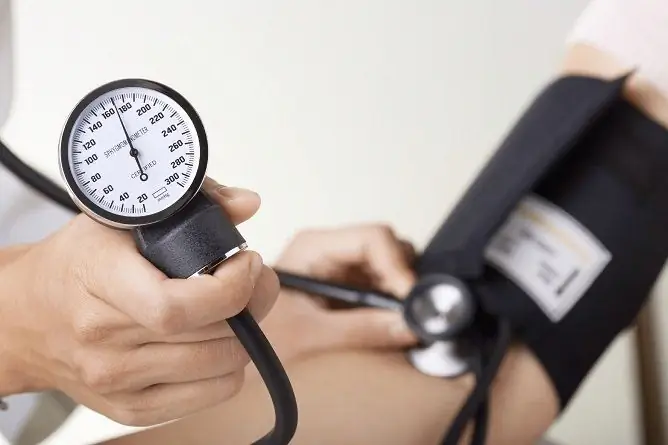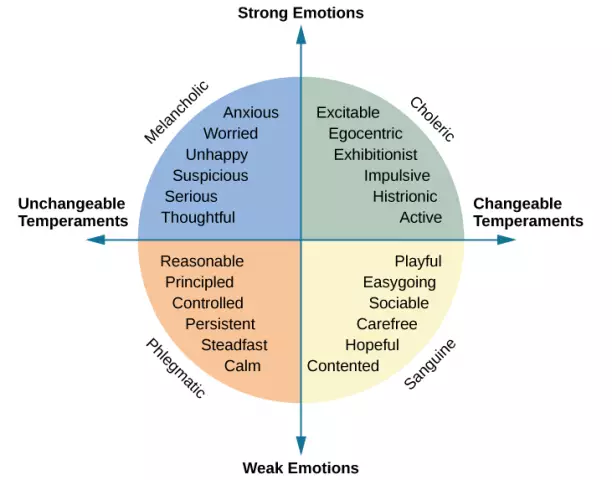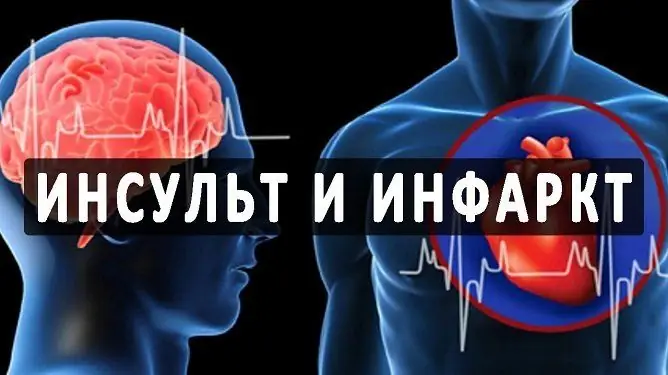- Author Rachel Wainwright [email protected].
- Public 2023-12-15 07:39.
- Last modified 2025-11-02 20:14.
What is the difference between hypertension and hypertension: differences, approach to diagnosis and treatment
The content of the article:
- What is the difference between hypertension and hypertension
- Etiology and pathogenesis
- Classification of arterial hypertension
- Diagnostics and treatment
- Video
What is the difference between hypertension and hypertension? Are these states identical, or is there a fundamental difference between them? Let's try to figure it out.
Every second inhabitant of the planet suffers from high blood pressure, this pathology has become a disease of civilization due to the fast pace of life, disturbances in circadian rhythms, constant stress and a decrease in the general resistance of the body. Everyone knows about hypertension in one way or another, but medical terminology is often used incorrectly by people, causing confusion. Usually two names are used to designate a state of high blood pressure (blood pressure) - hypertension and hypertension, but they are not the same thing.

Hypertension - an increase in blood pressure that can be long-term or short-term
What is the difference between hypertension and hypertension
Clinically, hypertension and hypertension are two absolutely identical conditions, but one of them is hierarchically higher, respectively, more dangerous than the other. What is the difference between hypertension and hypertension?
Hypertension, or rather, arterial hypertension, is a condition of persistent and prolonged increase in blood pressure. It is not a disease, but only a symptom, a measurable sign of a disease. Every time a person's blood pressure rises for any of the reasons, even due to physical exertion, arterial hypertension is recorded, that is, high blood pressure.
Hypertension, aka hypertension, is a disease, the main symptom of which is persistent arterial hypertension, mentioned above. This is a symptom complex that can be accompanied by dangerous complications from the target organs. Hypertension can be essential, or primary, that is, arising independently, for no apparent reason, and not due to damage to organs that control pressure (heart, kidneys). Secondary hypertension is the result of damage to organs that determine the level of blood pressure.
Based on this, in the context of the disease, the term hypertension should be used, and in the context of the symptom - hypertension. Everyone should know in more detail about the causes and mechanism of development of this pathology in order to understand the vicious circle of the pathogenesis of high blood pressure.
Etiology and pathogenesis
In more than 95% of hypertensive cases, it is caused by primary essential hypertension. Only 5% of all clinical cases of persistent increase in blood pressure are associated with disturbances in the work of certain systems that are responsible for maintaining it.
Since essential hypertension is a polyetiological disease, and the mechanism of its occurrence is not completely open, risk factors are distinguished that have been statistically proven to increase the risk of this pathology.
Genetic studies show that the most important factor is hereditary predisposition - presumably hypertension is caused by a mutation of receptors for antiotensin, a powerful vasoconstrictor peptide in the human body. Also, risk factors include:
- overweight - obesity increases the risk of developing persistent hypertension several times;
- smoking - constant spastic vascular contractions under the influence of nicotine lead to disruption of the innervation of the vascular wall, which makes it unable to fully compensate for the force of cardiac output;
- excess salt in the diet - sodium chloride is an osmotically active substance that retains water in the body, which leads to swelling of the endothelium (inner lining) of blood vessels, narrowing of their lumen;
- hypodynamia - an insufficiently active lifestyle leads to muscle weakness, this also applies to the heart muscle, which atrophies without sufficient stress, and the vascular wall weakened and becomes less capable of contraction. In this case, the heart ejects more blood than the vascular system can absorb;
- age - with age, the number of elastic collagen fibers in the body decreases rapidly, and elastic structures, including blood vessels, become brittle. More than half of all people over 40 experience persistent high blood pressure;
- psycho-emotional background - frequent stresses, a fast pace of life, lack of sleep and wakefulness lead to an overload of the nervous system, which, in turn, negatively affects the heart and blood vessels.
In terms of etiology, hypertension differs from hypertension only in that it can be secondary, caused by disorders in other organs and systems. Most often, this is renal hypertension in renal failure, which is realized through several mechanisms - usually this is a deterioration in filtration, and hence the removal of excess water from the body, which increases the volume of circulating blood and pressure. Also important is the release of renin by the kidneys, which triggers a complex cascade of reactions leading to the production of angiotensin II, the most powerful vasoconstrictor (i.e., vasoconstrictor) in the body.
Another form of secondary hypertension is endocrine hypertension, which is associated with the release of vasopressin by the pituitary gland. This hormone also constricts blood vessels, thereby increasing blood pressure. It is necessary to differentiate primary hypertension from secondary, since the approach to their treatment is different - with essential hypertension, this is the elimination of symptoms, and with secondary hypertension, the fight against the underlying pathology.

Hypertension affects more than half of all people over 40
Classification of arterial hypertension
Another difference between hypertension and hypertension is that hypertension is not classified as a separate classification and is considered in terms of a general persistent increase in hydrodynamic pressure.
There are two main classifications of hypertension by stages - one of them is based on clinical manifestations, and the other on the blood pressure indicator.
What are the stages of clinical classification?
- The pressure is above normal for most of the day, but there is no damage to the target organs (also called shock organs). This stage is most favorable for treatment.
- The first signs of damage in target organs are observed: microscopic damage to blood vessels, hemorrhages in the parenchyma of shock organs, in particular the kidneys, liver, and brain.
- A dangerous condition in which the shock organs are seriously affected, their insufficiency develops, the body cannot compensate for the increased blood pressure. This stage is often complicated by hypertensive crises - an acute increase in blood pressure exceeding 200 mm Hg. Art. Prolonged hypertension leads to damage to the microvasculature, retinopathy, angiopathy, edema of the optic nerve disc and other pathologies.
According to the level of blood pressure, the following degrees of the pathological condition are distinguished:
- Optimal BP: SBP (systolic blood pressure) <120 / DBP (diastolic blood pressure) <80 mm Hg. Art.
- Normal blood pressure: SBP 120-129 / DBP 80-84 mm Hg. Art.
- High-normal blood pressure: SBP 130-139 / DBP 85-89 mm Hg. Art.
- Isolated systolic hypertension: SBP above or equal to 140 / DBP below 90.
Diagnostics and treatment
The main diagnostic difference between hypertension and hypertension is that hypertension is diagnosed by indirect changes in the vascular bed and the state of individual organs, while arterial hypertension is established on the basis of daily monitoring of blood pressure.
The patient wears a portable tonometer for several days, during which the diagnostic process takes place. It measures blood pressure in the daytime and at night, and based on the data obtained, a diagnosis is made. The doctor, making adjustments for physical activity, analyzes the total time of high blood pressure.

Characteristic changes in the fundus confirm hypertension
An informative study is the examination of the fundus. With prolonged hypertension, the retinal vessels change, thicken and contour. If the ophthalmologist detects characteristic crushing of the fundus vessels, edema of the optic nerve disc, or other signs of retinopathy, the diagnosis is confirmed. Additional diagnostic methods are echocardiography for the analysis of cardiac output and laboratory blood tests.
Treatment is usually symptomatic - most often used ACE blockers (angiotensin converting enzyme), diuretics, calcium channel blockers, beta-blockers.
Video
We offer for viewing a video on the topic of the article.

Nikita Gaidukov About the author
Education: 4th year student of the Faculty of Medicine No. 1, specializing in General Medicine, Vinnitsa National Medical University. N. I. Pirogov.
Work experience: Nurse of the cardiology department of the Tyachiv Regional Hospital No. 1, geneticist / molecular biologist in the Polymerase Chain Reaction Laboratory at VNMU named after N. I. Pirogov.
Found a mistake in the text? Select it and press Ctrl + Enter.






